Abstract
In this study, we investigate the pricing of two types of vulnerable foreign equity options using an intensity-based model. It is considered that the intensity process consists of both systematic and idiosyncratic components. In addition, we assume that the underlying asset processes follow a two-factor stochastic volatility model. Under the proposed model, we obtain the explicit pricing formulas of vulnerable foreign equity options. Finally, we provide some numerical examples to demonstrate how credit risk and stochastic volatility affect option prices.
MSC:
91G20; 91G40
1. Introduction
The suitable valuation of financial derivatives with credit risk has become increasingly important since the 2008 global financial crisis, which exposed the potential risks of underestimating counterparty risk. While the Black–Scholes model [1] is the basis of option pricing, the assumption of risk-free counterparties has proven insufficient, especially in over-the-counter (OTC) markets, where credit risk occurs in each transaction. In other words. as OTC markets have increased in size and complexity, incorporating credit risk into derivative pricing has become not only important but essential.
Two main approaches for modeling credit risk in options were developed: structural models and intensity-based (reduced-form) models. The structural models, developed by Johnson and Stulz [2] and expanded by Klein [3], define default as occurring when the counterparty’s assets fall below a predetermined threshold. While obvious, structural models have limitations due to the assumption that a firm’s asset value is observable and the difficulty of capturing unexpected defaults. Jarrow and Turnbull [4] proposed intensity-based models, which were later extended by Lando [5], providing an alternative model in which default is considered an exogenous event governed by the Cox process. This approach has several advantages; it better demonstrates the unpredictable character of defaults, allows for more flexible correlation structures, and frequently results in more tractable mathematical expressions. In addition, intensity-based models can better incorporate market data from credit default swaps and corporate bonds. In this paper, we consider an intensity-based model to model the credit risk.
Our study provides an alternative approach for foreign equity options with credit risk, a popular but understudied type of exotic derivative. Kwok and Wong [6] first provided the pricing formulas of different foreign equity options under the Black–Scholes model based on the partial differential equation (PDE) approach. Meanwhile, foreign equity options have been extensively studied since Kwok and Wong’s primary work, with extensions to the Lévy process [7], stochastic volatility [8,9], regime switching [10], and jump diffusion [11,12]. Several recent studies have focused on the valuation of foreign equity options while considering the credit risk of the counterparty. Kim et al. [13] used Mellin transforms to solve the PDEs for the prices of foreign equity options with credit risk under the structural model. Kim [14] derived the pricing formulas of vulnerable foreign equity options in the intensity-based model using the mean-reverting OU process for the intensity process based on Fard’s model [15] by employing the probabilistic approach. However, these studies have limitations because they used the Black–Scholes model. In this paper, we develop the model for pricing vulnerable foreign equity options using stochastic volatility models, which describe the volatility smile in the real market. Furthermore, we adopt an adequate intensity-based approach to model the credit risk of vulnerable foreign equity options. We describe the stochastic default intensity using a Cox–Ingersoll–Ross (CIR) process, which allows for mean reversion in credit risk while remaining analytically tractable. This captures the empirically observed clustering of defaults and the temporal variability of credit risk.
The remainder of this paper is structured as follows. Section 2 describes our model framework and introduces two types of vulnerable foreign equity options. Section 3 presents the analytical pricing formulas of the options. Section 4 provides some numerical examples. Finally, Section 5 offers some concluding remarks.
2. Model
We assume that and are the prices of foreign and domestic stocks, respectively. The relation between and can be described as , where denotes the exchange rate in the domestic currency per unit of foreign currency at time t. We also assume that the risk-neutral dynamics and in foreign currency, which have two-factor stochastic volatility, are given by
where and are constants, represents standard Brownian motions, and and denote the domestic and foreign risk-free interest rates, respectively. In addition, we have
where are constants and represents the standard Brownian motions. The standard Brownian motions mentioned above have the following correlations:
and other Brownian motions are pairwise independent. Then, under the domestic risk neutral measure Q, the dynamics in a domestic currency are represented by
In the following, we consider an intensity-based model for modeling the credit risk of an option issuer. As in the work by Wang [16], we assume that the intensity process is divided into two parts. The first part examines systematic risk, while the second examines the idiosyncratic risk of option issuers. Then, the intensity process is defined by
where is is a nonnegative constant and describes the idiosyncratic risk, defined by
where are constants and is a standard Brownian motion independent of all other Brownian motions. Then, the default is defined by
where and T is the time to maturity.
In this paper, we consider two kinds of foreign equity options:
- (1)
- The payoff of foreign equity call struck in foreign currency:
- (2)
- The payoff of foreign equity call struck in domestic currency:
Here, and are the strike prices in foreign and domestic currency, respectively. Then, in the intensity-based model, the prices of vulnerable foreign equity options at time 0 under the measure Q are given by
where w is the recovery rate satisfying . For more details, see the work of Fard [15].
3. The Valuation of Vulnerable Foreign Equity Options
In this section, we derive the pricing formulas of vulnerable foreign equity options in the proposed framework. To obtain the pricing formulas of the options defined in (5) and (6), we employ a probabilistic approach using the joint characteristic function of under the measure Q. The function is given by
where represents the complex numbers. We provide the explicit expression of the function in the following proposition.
Proposition 1.
Under the risk neutral measure Q, we have that
where
Proof.
From the volatility process , we have
In addition, and are similarly represented as shown above.
With the above results, and are given by
where and are standard Brownian motions which are independent of other Brownian motions and defined by
Since is a constant, and is independent of and , we have that
By applying the law of the iterated expectation to , we have that
Since , and are pairwise independent, we have
Then, the characteristic function can be represented by
where G, and are defined in Proposition 1.
Based on the properties of the characteristic function and the measure change technique, we can obtain the prices of the vulnerable foreign equity call struck in foreign currency and vulnerable foreign equity call struck in domestic currency under the proposed framework. In particular, the pricing formula for (5) is given in the following proposition.
Proposition 2.
The price of vulnerable foreign equity call struck in foreign currency at time 0 is given by
where
Proof.
Recall the price of the vulnerable option in (5). Then, the option price can be decomposed as follows:
where
We first consider the calculation of . To obtain the explicit solution of , we employ a new probability measure , which is equivalent to Q and defined by the Radon–Nikodým derivative:
Then, the characteristic function of under the measure is given by
By applying the standard probability theory in [17], we have that
In a similar way to that described above, we can derive . For in (17), we use a new probability measure , defined below:
Under the measure , the characteristic function has the form of
Using the characteristic function , one can find that
is calculated in a similar fashion to . This completes the proof of Proposition 2. □
Similarly, the pricing formula for (6) is provided in the following proposition.
Proposition 3.
The price of vulnerable foreign equity call struck in domestic currency at time 0 is given by
where
Proof.
For the calculation of , we introduce the probability measure defined in (18). Then, the characteristic function of under the measure is given by
Using the function , can be calculated as follows:
In addition, , , and in (23) can be obtained in a similar manner. This completes the proof of Proposition 3. □
4. Numerical Examples
This section includes numerical examples demonstrating how the credit risk of the option issuer affects the prices of options and their sensitivity to significant parameters. The numerical examples present the prices of vulnerable foreign equity call struck in domestic currency and vulnerable foreign equity call struck in foreign currency. Obviously, both options have similar payoff functions, and thus we can find similar movements through experiments. Table 1 indicates the parameter values for the base case, which are based on the works of Ma [8] and Wang [16].

Table 1.
Parameter values in the base case.
Figure 1 illustrates the values of two kinds of vulnerable foreign equity options for three recovery rate scenarios under the proposed stochastic volatility model. Figure 1 shows that option prices grow logarithmically as the maturity T increases. This illustrates how option prices grow with maturity. Also, as expected, option prices with a high recovery rate w are higher than those with a low recovery rate w. Option prices with credit risk tend to decrease as w falls, which makes clear sense.
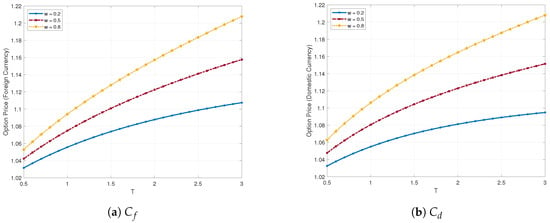
Figure 1.
The impact of the maturity T and recovery rate w on the option price.
Figure 2 demonstrates how the initial stock price affects option prices under different recovery rates. Both foreign and domestic currency options exhibit similar behavior, with prices increasing proportionally with . The effect of the recovery rate w is relatively small when the option is deep out of the money (low ) but becomes greater as the option becomes in the money (high ). This indicates that credit risk considerations are more significant for options with higher intrinsic value. Figure 3 illustrates the impact of stock price volatility on option prices. As expected, higher volatility leads to higher option prices across all recovery rates, demonstrating the fundamental relationship between volatility and the option value. This relationship holds true for both foreign and domestic currency options, despite domestic currency options being slightly more sensitive to volatility changes.
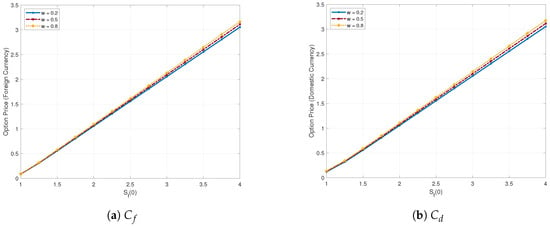
Figure 2.
The impact of the initial stock value and recovery rate w on the option price.
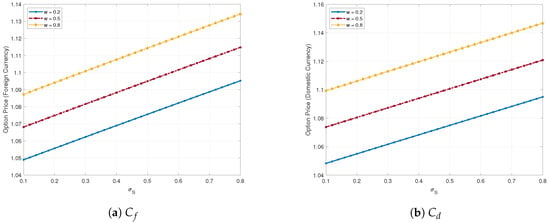
Figure 3.
The impact of the volatility and recovery rate w on the option price.
Figure 4 shows how the initial volatility affects option prices. The relationship is inverse; as the initial volatility increases, option prices decrease. This unexpected outcome can be explained by the interaction between credit risk and . This is because initial volatility generates a high default intensity, which increases the credit risk of option issuers. The effect is significant for smaller recovery rates, implying that a high increases credit risk issues. Figure 5 examines the relationship between the systematic risk parameter and option prices. As increases, option prices decrease across all recovery rates, with the effect being strongest for low recovery rates. This indicates how systematic risk has a direct impact on credit risk pricing, with higher systematic risk exposure resulting in larger price discounts. The effect is especially noticeable when w = 0.2, indicating that systemic risk issues are particularly significant when recovery rates are low. The case where w = 1 (no credit risk) served as an upper bound and showed no sensitivity to , showing that exclusively influences prices through credit risk.
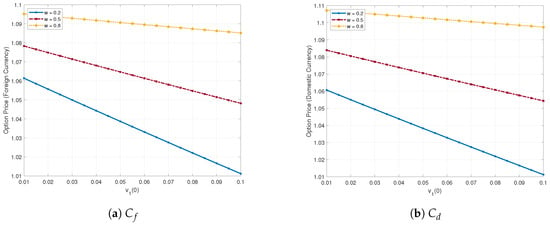
Figure 4.
The impact of the initial volatility and recovery rate w on the option price.
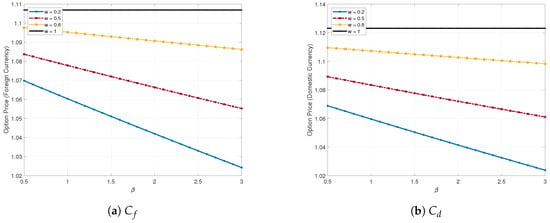
Figure 5.
The impact of the value of and recovery rate w on the option price.
5. Concluding Remarks
This study presented and analyzed an extensive approach for pricing vulnerable foreign equity options which incorporates both stochastic volatility and credit risk using an intensity-based model. We derived explicit pricing formulas for two types of vulnerable foreign equity options with credit risk under a two-factor stochastic volatility model using the characteristic function and measure change techniques. The intensity-based model for determining credit risk covers both the systematic and idiosyncratic components of default intensity, providing a more realistic framework for pricing these options. In addition, we provided several numerical examples to demonstrate the impact of various parameters on option prices.
In this paper, we considered a two-factor stochastic volatility model for describing underlying assets. While the stochastic volatility model is a sufficient and appropriate model for real markets, jump diffusion models, regime-switching models, and others can be considered to extend the underlying asset models. Furthermore, to extend our results, it is also possible to consider models with liquidity risk, such as the recent work of Jeon and Kim [18]. In the future, these will be studied via the probabilistic approach with numerical methods.
Author Contributions
J.J. and G.K. designed the model; J.J. and G.K. contributed to the analysis of the mathematical model; J.J. proved the propositions in this paper; J.J. and G.K. wrote this paper. All authors have read and agreed to the manuscript.
Funding
This research was supported by Seoul National University of Science and Technology.
Data Availability Statement
The original contributions presented in this study are included in the article. Further inquiries can be directed to the corresponding author(s).
Conflicts of Interest
The authors declare no conflicts of interest.
References
- Black, F.; Scholes, M. The pricing of options and corporate liabilities. J. Political Econ. 1973, 81, 637–654. [Google Scholar] [CrossRef]
- Johnson, H.; Stulz, R. The pricing of options with default risk. J. Financ. 1987, 42, 267–280. [Google Scholar] [CrossRef]
- Klein, P. Pricing Black-Scholes options with correlated credit risk. J. Bank. Financ. 1996, 20, 1211–1229. [Google Scholar] [CrossRef]
- Jarrow, R.; Turnbull, S. Pricing options on financial securities subject to default risk. J. Financ. 1995, 50, 53–86. [Google Scholar] [CrossRef]
- Lando, D. On Cox processes and credit risky securities. Rev. Deriv. Res. 1998, 2, 99–120. [Google Scholar] [CrossRef]
- Kwok, Y.K.; Wong, H.Y. Currency-translated foreign equity options with path dependent features and their multi-asset extensions. Int. J. Theor. Appl. Financ. 2000, 3, 257–278. [Google Scholar] [CrossRef]
- Huang, S.C.; Hung, M.W. Pricing foreign equity options under Lévy processes. J. Futur. Mark. Futur. Options Other Deriv. Prod. 2005, 25, 917–944. [Google Scholar] [CrossRef]
- Ma, J. Pricing Foreign Equity Options with Stochastic Correlation and Volatility. Ann. Econ. Financ. 2009, 10, 303–327. [Google Scholar]
- Sun, Q.; Xu, W. Pricing foreign equity option with stochastic volatility. Phys. A Stat. Mech. Its Appl. 2015, 437, 89–100. [Google Scholar] [CrossRef]
- Fan, K.; Shen, Y.; Siu, T.K.; Wang, R. Pricing foreign equity options with regime-switching. Econ. Model. 2014, 37, 296–305. [Google Scholar] [CrossRef]
- Xu, W.; Wu, C.; Li, H. Foreign equity option pricing under stochastic volatility model with double jumps. Econ. Model. 2011, 28, 1857–1863. [Google Scholar] [CrossRef]
- Ma, Y.; Pan, D.; Shrestha, K.; Xu, W. Pricing and hedging foreign equity options under Hawkes jump–diffusion processes. Phys. A Stat. Mech. Its Appl. 2020, 537, 122645. [Google Scholar] [CrossRef]
- Kim, D.; Yoon, J.H.; Kim, G. Closed-form pricing formula for foreign equity option with credit risk. Adv. Differ. Equ. 2021, 2021, 332. [Google Scholar] [CrossRef]
- Kim, G. A Simplified Approach to the Pricing of Vulnerable Options with Two Underlying Assets in an Intensity-Based Model. Axioms 2023, 12, 1105. [Google Scholar] [CrossRef]
- Fard, F.A. Analytical pricing of vulnerable options under a generalized jump–diffusion model. Insur. Math. Econ. 2015, 60, 19–28. [Google Scholar] [CrossRef]
- Wang, X. Analytical valuation of vulnerable European and Asian options in intensity-based models. J. Comput. Appl. Math. 2021, 393, 113412. [Google Scholar] [CrossRef]
- Shephard, N.G. From characteristic function to distribution function: A simple framework for the theory. Econom. Theory 1991, 7, 519–529. [Google Scholar] [CrossRef]
- Jeon, J.; Kim, G. Analytically Pricing a Vulnerable Option under a Stochastic Liquidity Risk Model with Stochastic Volatility. Mathematics 2024, 12, 2642. [Google Scholar] [CrossRef]
Disclaimer/Publisher’s Note: The statements, opinions and data contained in all publications are solely those of the individual author(s) and contributor(s) and not of MDPI and/or the editor(s). MDPI and/or the editor(s) disclaim responsibility for any injury to people or property resulting from any ideas, methods, instructions or products referred to in the content. |
© 2025 by the authors. Licensee MDPI, Basel, Switzerland. This article is an open access article distributed under the terms and conditions of the Creative Commons Attribution (CC BY) license (https://creativecommons.org/licenses/by/4.0/).